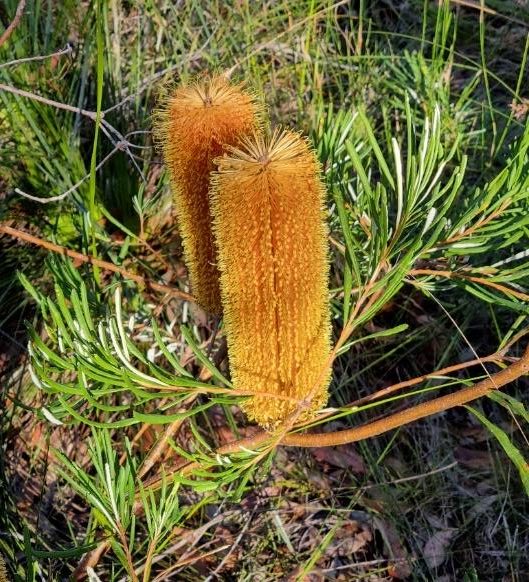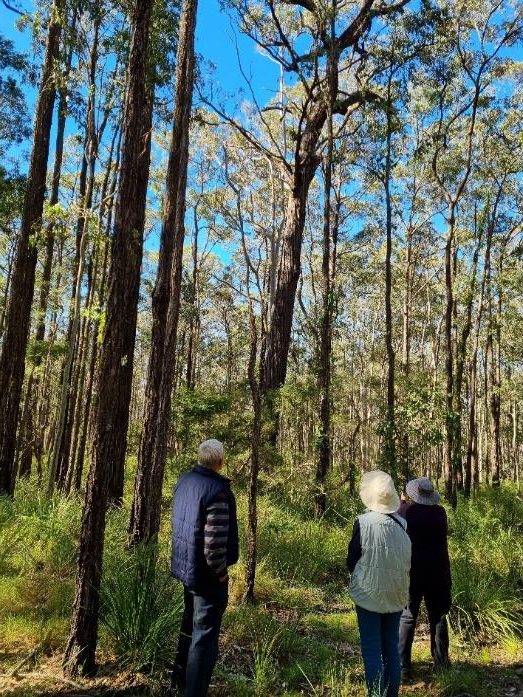On Saturday 27th May, eight of us congregated at the country property, ‘Parragilga’, of Phil Baird, one of our members. It is in an area called The Branch, north of both the Hunter and Karuah Rivers, and east of Buckets Way, the road to Gloucester. The property once belonged to a logging family, but for a very long time has been untouched and allowed to regenerate. It is woodland with tall trees, grasses and a variable collection of not very high under-shrubs. There is remarkably little weed. Phil has had a botanist flora survey done for the council, which shows over 200 different species.
Initially, we had a small walk around the level of the house, the highest part of the property. The most common tree species are Eucalyptus fibrosa, an ironbark, and Corymbia maculata, a spotted gum. Acacia terminalis was flowering, a pale-yellow form. Near the house, Phil had planted Grevillea guthrieana, an endangered plant only found in this area and around Buladelah.
After lunch, we had a longer walk down the slashed fire trails to the main attraction at this time of year. Quite a large area supports a great many Banksia spinulosa plants, flowering furiously. They show a collection of different colours in their styles. Some are bright gold, or various shades of red, and some are very dark, almost black. They are beautiful. Because of a recent severe storm over Newcastle, the fire trails became increasingly wet, so we didn’t progress to the strip of rainforest flora along the Branch River, one of Phil’s boundaries. Light was fading fast by the time we left. Many thanks to Phil, who is a great host.
Plants seen by the group included:
Acacia floribunda
Acacia longifolia
Acacia myrtifolia
Acacia terminalis
Allocasuarina torulosa
Banksia oblongifolia
Banksia spinulosa
Billiardiera scandens
Bursaria spinosa
Corymbia gummifera
Eucalyptus maculata
Daviesia ulicifolia
Epacris pulchella
Eucalyptus fibrosa
Glochidion ferdinandi
Glycine clandestina
Glycine tabacina
Hardenbergia violacea
Isolepis inundata
Kennedia rubicunda
Leptospermum
polygalifolium
Leucopogon juniperinus
Lomandra longifolia
Lomandra obliqua
Notelaea longifolia
Ozothamnus diosmifolius
Parsonsia straminea
Persoonia levis
Persoonia linifolia
Pratia purpurascence
Pultenea villosa
Zieria smithii
Five of us stayed in the area overnight and met at 10 am at the Hunter Wetlands Centre in Shortland, an outer suburb of Newcastle. If you are going there, be aware that there is also a Hunter Wetlands National Park, a different place altogether. The Shortland one has a collection of large ponds, swamps and marshes, populated by a great variety of Australian water birds: ducks, swans, egrets, geese, moorhens and many more. A network of paths winds around these with some bird hides and other interest points. There is an enclosure featuring a freckled duck, pretty with dark plumage and small yellow spots. The signage explains that this is a very primitive species of duck.
The Newcastle District APS Group is heavily involved with the Wetlands, and has planted native plants around the Centre building. They also sell plants produced by their very active propagation group. The Centre is a two-story building, giving a view over the wetlands. It contains lots of explanatory maps and leaflets, a shop and a very good café, with a large verandah area, as well as education facilities on the lower level. On walking around the wetlands there are areas of rainforest. There is also a very good wild food display area, showing lots of labelled plants, and signs explaining the uses of many of them. A visit here is different from our usual activities, and is very interesting and worthwhile.




Thanks to Pip, Ricki and Jennifer for these photos from the weekend away . . .








